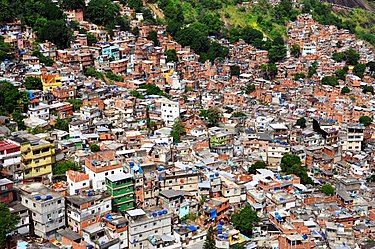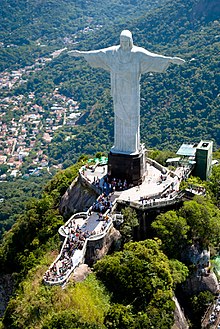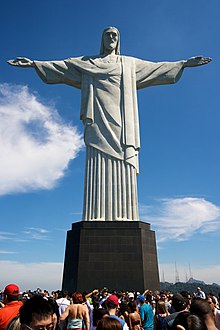Thursday, November 14, 2019, Rio de Janeiro, Brazil
The Christ Statue & Tijuca Forest
Exhilarating Rio de Janeiro is the peak of Brazilian culture. The local Cariocas call their city Cidade Maravilhosa ("Marvelous City"), and it is easy to under-stand why: The rhythm of the samba, born in these lively streets, fills the air and stately colonial architecture rubs shoulders with gleaming skyscrapers. Legendary beaches, Copacabana and Ipanema among them, stretch for 45 miles along Guanabara Bay, luring sun worshipers, swimmers, joggers, and volleyball enthusiasts. The Christ the Redeemer statue seems to offer a gentle embrace to it all from high atop Corcofado mountain.
Christ the Redeemer is an Art Deco statue of Jesus Christ in Rio de Janeiro, Brazil, created by French sculptor Paul Landowski and built by Brazilian engineer Heitor da Silva Costa, in collaboration with French engineer Albert Caquot. Romanian sculptor Gheorghe Leonida fashioned the face. Constructed between 1922 and 1931, the statue is 98 feet high, excluding its 26 foot pedestal. The arms stretch 92 feet wide.
The statue weighs 625 tons, and is located at the peak of the 2,300 foot Corcovado mountain in the Tijuca Forest National Park overlooking the city of Rio de Janeiro. A symbol of Christianity across the world, the statue has also become a cultural icon of both Rio de Janeiro and Brazil, and is listed as one of the New7Wonders of the World. It is made of reinforced concrete and soapstone.
Corcovado, means "hunchback" in Portuguese, is a mountain in central Rio de Janeiro, Brazil. It is a 2,329 foot granite peak located in the Tijuca Forest, a national park. It is sometimes confused with nearby Sugarloaf Mountain.
Corcovado hill lies just west of the city center but is wholly within the city limits and visible from great distances. It is known worldwide for the 125 foot statue of Jesus atop its peak, entitled Cristo Redentor or "Christ the Redeemer."
The peak and statue can be accessed via a narrow road, by the 2.4 mile Corcovado Rack Railway, which was opened in 1884 and refurbished in 1980, or by the walking trail on the south side of the mountain that starts from Parque Lage. The railway uses three electrically powered trains, with a passenger capacity of 540 passengers per hour. The rail trip takes approximately 20 minutes and departs every 20 minutes. Due to its limited passenger capacity, the wait to board at the entry station can take several hours. The year-round schedule is 8:30 to 18:30.
From the train terminus and road, the observation deck at the foot of the statue is reached by 223 steps, or by elevators and escalators. Among the most popular year-round tourist attractions in Rio, the Corcovado railway, access roads, and statue platform are commonly crowded.
The most popular attraction of Corcovado mountain is the statue and viewing platform at its peak, drawing over 300,000 visitors per year. From the peak's platform the panoramic view includes downtown Rio, Sugarloaf Mountain, the Lagoa Rodrigo dereitas (lake), Copacabana and Ipanema beaches, Estádio do Maracanã (Maracanã Stadium), and several of Rio's favelas. Cloud cover is common in Rio and the view from the platform is often obscured. Sunny days are recommended for optimal viewing.
Notable past visitors to the mountain peak include Pope Pius XII, Pope John Paul II, Alberto Santos-Dumont, Albert Einstein, Diana, Princess of Wales, and General Sherman, among others. An additional attraction of the mountain is rock climbing. The south face had 54 climbing routes in 1992. The easiest way starts from Park Lage.
The Corcovado is also a symbol of the Brazilian culture.
We ascended high above Rio de Janeiro and visited its most famous landmark. Located on the granite-domed peak of Corcovado mountain, the Christ the Redeemer statue spreads its arms out in a welcoming embrace to the city below. Covered in more than 6 million soapstone tiles, this art deco statue is 98 feet tall and has an arm span of 92 feet. A cog railway took us to the statue’s base, where we enjoyed stunning views of Rio from above. Our journey also took us through Tijuca Forest, one of the largest urban forests in the world. This dense tropical rain forest suffered from deforestation in the 19th century, when much of it was cleared to accommodate coffee plantations. A century-long reclamation project planted more than 100,000 trees, and today this national park is a favorite spot in which to relax, far from the noise of the city.
Waiting line for the cog railway.
Picture sign while in line.
Railway maintenance shed.
Cog rail.
Arriving rail cars from above.
Chapel inside base of statue.
More than one way to view the statue.
Yet another way to view the statue.
Sugarloaf Mountain in the distance above the buildings.
Sugarloaf Mountain is a peak situated in Rio de Janeiro, Brazil, at the mouth of Guanabara Bay on a peninsula that juts out into the Atlantic Ocean. Rising 1,299 feet above the harbor, its name is said to refer to its resemblance to the traditional shape of concentrated refined loaf sugar. It is known worldwide for its cableway and panoramic views of the city and beyond.
The mountain is one of several monolithic granite and quartz mountains that rise straight from the water's edge around Rio de Janeiro. Geologically it is considered part of a family of steep-sided rock outcroppings known as non-inselberg bornhardts.
The mountain is protected by the Sugarloaf Mountain and Urca Hill Natural Monument, created in 2006. This became part of a World Heritage Site declared by UNESCO in 2012.
The name Sugarloaf was coined in the 16th century by the Portuguese during the heyday of sugarcane trade in Brazil. According to historian Vieira Fazenda, blocks of sugar were placed in conical molds made of clay to be transported on ships. The form of the peak reminded them of the well-known resulting "sugarloaf" shape, and the nickname has since been extended to be a general descriptor for formations of this kind.
A glass-walled cable car, capable of holding 65 people, runs along a 4,600 foot route between the peaks of Sugarloaf and Morro da Urca every 20 minutes. The original cable car line was built in 1912 and rebuilt around 1972–73 and in 2008. The cable car goes from a ground station, at the base of Morro da Babilônia, to Morro da Urca and then to Sugarloaf's summit.
Copacabana is a bairro (neighborhood) located in the South Zone of the city of Rio de Janeiro, Brazil. It is known for its 2.5 miles balneario beach, which is one of the most famous in the world. The area got its start in 1927 with the construction of its first hotel, Copacabana Hotel. It has blossomed ever since.
Our cruise ship is in the center of picture, between the two dark towers.

On our way down to city level we passed numerous "bread fruit" trees.
Breadfruit (Artocarpus altilis) is a species of flowering tree in the mulberry and jackfruit family (Moraceae) believed to be a domesticated descendant of Artocarpus camansi originating in New Guinea, the Maluku Islands, and the Philippines. It was initially spread to Oceania via the Austronesian expansion. It was further spread to other tropical regions of the world during the Colonial Era. British and French navigators introduced a few Polynesian seedless vari-eties to Caribbean islands during the late 18th century. Today it is grown in some 90 countries throughout South and Southeast Asia, the Pacific Ocean, the Caribbean, Central America, and Africa. Its name is derived from the texture of the moderately ripe fruit when cooked, similar to freshly baked bread and having a potato-like flavor.
The trees have been widely planted in tropical regions, including lowland Central America, northern South America, and the Caribbean. In addition to the fruit serving as a staple food in many cultures, the light, sturdy timber of breadfruit has been used for outriggers, ships, and houses in the tropics.
Breadfruit is closely related to Artocarpus camansi (breadnut or seeded bread-fruit) of New Guinea, the Maluku Islands, and the Philippines, Artocarpus blancoi (tipolo or antipolo) of the Philippines, and Artocarpus mariannensis (dugdug) of Micronesia, all of which are sometimes also referred to as "bread-fruit." It is also closely related to Artocarpus heterophyllus (jackfruit).

After 25+ busy hours in Rio, we are on our way to Montevideo, Uruguay. We will need two sea days to get there, arriving 7 AM, Sunday, November 18.





























Looks like a beautiful and exciting city. Safe travels!
ReplyDelete